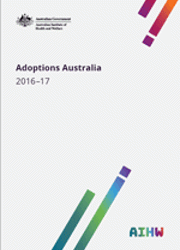Summary
Adoption numbers increased
In 2016–17, 315 adoptions were recorded as finalised. This is an increase of 13% from 2015–16 when there were 278 adoptions—the lowest number on record. This rise in finalised adoptions occurred against a backdrop of a 60% decline in Australia over the past 25 years.
Known child adoptions made up almost two-thirds of all adoptions
While other types of adoption have declined, ‘known child’ adoptions—where the child is already known to the adoptive parent(s)—have increased over the past decade, from 100 in 2007–08 to 204 in 2016–17. These adoptions comprised 65% of all finalised adoptions in 2016–17, with adoptions by carers, such as foster parents, the most common (70%). The increase in known child adoptions is largely the result of a policy change in New South Wales which has resulted in a higher number of adoptions from care.
Local and intercountry adoptees were younger than known child adoptees
Adoption of Australian children not known to their adoptive parents are called ‘local’ adoptions. In 2016–17, 42 local adoptions were finalised, representing 13% of all adoptions. A further 69 adoptions of children from countries other than Australia, referred to as ‘intercountry’ adoptions, were also finalised. All local adoptees, and 74% of intercountry adoptees, were aged under 5. The majority of known child adoptees (80%) were aged 5 and over.
Intercountry processing times fell
For intercountry adoption, the median length of time from when an adoptive parent became an official client of an Australian state or territory department responsible for adoption, to when a child was placed for adoption had been increasing since 2007–08 (when data were first reported). It peaked at 5 years and 4 months in 2014–15 but then fell in 2015–16 and 2016–17. The median time was 2 years and 9 months in 2016–17.
The median length of time from when applicants became official clients of the department to when a child was placed with them varied considerably across countries. For example, it was just under 2 years for Hong Kong but over 6 years for Thailand.
Intercountry adoptions—100% were from Asian countries
In 2016–17, 100% of finalised intercountry adoptions were for adoptees from Asian countries. The most common countries of origin were Taiwan, comprising 35% of intercountry adoptions, followed by the Philippines (26%), South Korea (20%) and Thailand (14%).
The main country of origin for intercountry adoptions has changed over time. Between
2006–07 and 2010–11, the main country of origin was either China or the Philippines; since then it has varied between Taiwan and the Philippines.
Few Indigenous children are adopted each year
In 2016–17, only 4 Indigenous children had adoption orders finalised in Australia, with 125 Indigenous children adopted over the past 25 years.



